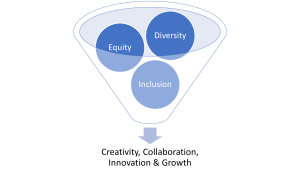Introduction
The past few years have seen a growing demand for Diversity, Equity, and Inclusion (DEI) in workplaces. The rationale behind this trend is straightforward: a diverse workforce is more innovative, productive, and can offer a wider range of perspectives that ultimately translates into higher profitability for the company. Yet, DEI is a complex issue, and implementing it in a way that is both effective and sustainable is not always easy, especially in the South Asian region, where cultural barriers can pose significant challenges. In this article, we will discuss the importance of DEI in the workplace, steps that corporate boards can take to implement it, and how culture plays a role in its adoption in the South Asian region.
The Importance of DEI in the Workplace
DEI is a critical component of any modern workplace. It refers to the policies, practices, and behaviors that promote equal opportunities and fair treatment for all employees, regardless of their gender, race, ethnicity, sexual orientation, or any other characteristic that may lead to discrimination. By promoting DEI, companies can create a more inclusive work environment that fosters creativity, collaboration, and innovation. This, in turn, can improve employee engagement and retention, boost productivity, and enhance customer satisfaction.
Moreover, studies have shown that companies with diverse workforces tend to be more profitable. For instance, a 2018 study by McKinsey & Company found that companies with gender-diverse executive teams were 21% more likely to experience above-average profitability. Similarly, companies with ethnically diverse executive teams were 33% more likely to outperform their peers. This demonstrates that a diverse workforce is not only good for social reasons, but also for the bottom line.
Steps to Implement DEI
To implement DEI, corporate boards must take a proactive approach. Here are some steps they can take:
- Conduct a DEI Assessment
Before implementing DEI policies and practices, companies should assess their current state of diversity, equity, and inclusion. This assessment should be comprehensive and include a review of the company’s policies, practices, and culture. It should also involve a survey of employees to gauge their perceptions of the company’s DEI efforts.
- Set Goals and Objectives
Based on the results of the assessment, companies should set clear and measurable goals and objectives for their DEI initiatives. These goals should be aligned with the company’s overall strategy and should be regularly reviewed and updated.
- Establish DEI Policies and Practices
Once the goals and objectives are in place, companies should establish DEI policies and practices that promote equal opportunities and fair treatment for all employees. These policies and practices should be integrated into all aspects of the company’s operations, including recruitment, training, performance management, and compensation.
- Provide DEI Training
To ensure that DEI policies and practices are understood and implemented correctly, companies should provide regular training to all employees. This training should cover topics such as unconscious bias, cultural competency, and effective communication.
- Monitor and Measure Progress
Finally, companies should monitor and measure their progress toward achieving their DEI goals and objectives. This should include regular reporting and analysis of diversity metrics, such as workforce demographics, turnover rates, and employee satisfaction.
Challenges to Implementing DEI in the South Asian Region
While DEI is important for all workplaces, implementing it in the South Asian region can be particularly challenging due to cultural barriers. In many South Asian countries, the concept of diversity is not widely understood or accepted, and discrimination based on gender, caste, religion, and ethnicity is still prevalent. This can make it difficult for companies to promote DEI and create a more inclusive work environment.
Moreover, South Asian cultures tend to be more hierarchical, with a greater emphasis on authority and respect for elders.
This can create a power dynamic in the workplace that can make it challenging for employees to speak up about issues related to DEI. In addition, South Asian cultures often value collectivism over individualism, which can make it harder for employees to challenge the status quo or advocate for their own needs.
Another challenge is the lack of representation of certain groups in leadership positions. In many South Asian countries, men still dominate senior positions in the workplace, and women and minorities are underrepresented. This lack of representation can lead to a lack of understanding and empathy for the challenges faced by these groups and make it more difficult to implement effective DEI policies and practices.
Furthermore, there can be resistance to change from those who have benefitted from the status quo. In many South Asian cultures, there is a tendency to resist change and maintain the existing power structure. This can make it challenging to convince decision-makers to prioritize DEI initiatives and allocate resources towards them.
Steps to Overcome Cultural Barriers and Implement DEI
“A diverse mix of voices leads to better discussions, decisions, and outcomes for everyone.”
— A quote by Sundar Pichai, Chief Executive Officer of Alphabet
Despite these challenges, there are steps that corporate boards can take to overcome cultural barriers and successfully implement DEI in the South Asian region. Here are some strategies that can be effective:
- Cultural Sensitivity Training
One of the most important steps that corporate boards can take is to provide cultural sensitivity training to all employees, including senior leadership. This training can help employees understand the cultural nuances and challenges that may exist in the workplace, as well as the importance of promoting diversity and inclusion.
- Communication and Dialogue
Another effective strategy is to promote open communication and dialogue within the workplace. Corporate boards should create safe spaces where employees can share their experiences and perspectives, without fear of retaliation or retribution. This can help build trust and foster a culture of openness and inclusion.
- Role Modeling
Leadership plays a crucial role in promoting DEI in the workplace. Corporate boards should ensure that senior leaders are committed to the cause and are actively promoting diversity and inclusion. They should lead by example and make DEI a top priority, both in their actions and in their communications.
- Diverse Hiring Practices
One of the most effective ways to promote DEI is through diverse hiring practices. Companies should actively seek out candidates from diverse backgrounds and ensure that their recruitment and selection processes are fair and inclusive. This can help to create a more diverse workforce, which can ultimately lead to a more innovative and productive company.
- Employee Resource Groups
Finally, companies can create Employee Resource Groups (ERGs) to provide support and advocacy for underrepresented groups. ERGs can help to create a sense of community and belonging for employees who may feel isolated or marginalized and can provide a platform for advocating for their needs and interests.
Conclusion
In conclusion, promoting DEI in the workplace is essential for creating a more inclusive, innovative, and profitable company. However, implementing DEI in the South Asian region can be particularly challenging due to cultural barriers. Corporate boards must take a proactive approach to overcome these challenges, including providing cultural sensitivity training, promoting open communication and dialogue, role modeling DEI behaviors, implementing diverse hiring practices, and creating Employee Resource Groups. By taking these steps, companies can create a more inclusive work environment that fosters creativity, collaboration, and innovation, and ultimately leads to higher profitability and success.
About the Author
Senela Jayasuriya
Author / Consultant specialized in DEI, L&D and Innovation
Coaching, Training, Assessments & Strategy
Global CEO, Women Empowered Global
Managing Director, Diverse Consultants
Board Member – McQuire Rens Global Consulting
Board Member – Zonta Club II of Colombo
Trainer Advisory Board Member – Personal Agility Institute
www.senelajayasuriya.com



